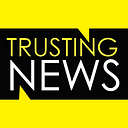Knight Commission report calls for ‘radical transparency’ in journalism. Trusting News can help.
A report and comprehensive set of proposals were published this morning by the Knight Commission on Trust, Media and Democracy.
We’ve been eagerly awaiting the commission’s findings, and it’s nice to see Trusting News cited in the report as a resource for journalists.
Their recommendations kick off with something that’s core to our work at Trusting News: radical transparency. Our focus is empowering journalists to actively demonstrate credibility and earn trust, and transparency is a big part of that. (Disclosure: Trusting News receives Knight Foundation funding.)
Practice radical transparency. The media should develop industrywide, voluntary standards on how to disclose the ways they collect, report and disseminate the news. The Commission calls for a convening of news leaders across competitive boundaries to work together to develop and adopt common standards and best practices that promote transparency. These include: labeling news, opinion and fact-based commentary; best practices on corrections, fact-checking, anonymous sources and tracking disinformation; and avoiding advertising formats that blur the line between content and commerce. They should also develop strategies to better engage with the public and reflect the interests of their communities.
Tom Rosenstiel, executive director of the American Press Institute (one of our partners), participated in the launch event for the report and had this to say: Radical transparency “is not simply a series of techniques. Radical transparency a mindset. It’s a spirit. It’s a way you go about thinking about your relationship with the audience.”
He went on to say that transparency is a culture change, not a checklist. It’s about revealing our motivations and intentions. We couldn’t agree more.
As we have previously written: Community newsrooms need to tell a consistent, repetitive story about what motivates their work, the range of information and stories they offer, what sets them apart, who they are, how they operate and how people can reach them. Telling that story should be a constant drumbeat — part of the rhythm of our work as journalists.
With the help of our newsroom partners, we’ve experimented with ways to adopt more transparency. (Sign up here to receive our weekly newsletter, Trust Tips, and also to be alerted when our new database of newsroom examples goes live soon at TrustingNews.org.)
Our transparency work falls into these overall categories:
- mission and motivation
- disclosure and ethics
- explanations around process
- news vs opinion
- accessibility and engagement
Mission and motivation
Explain the principles that guide your work. Do it clearly, and talk directly to your audience.
Collect those general principles in one place, like WITF did here and WCPO did here.
We know these statements of purpose are not things many Americans assume to be true. Journalists are not given the benefit of the doubt by the people they aim to serve. Our work is too often not perceived as being done on the public’s behalf.
Your statement of purpose should live not just on your “About” page but within your daily journalism. (Have you checked the views of your “About” page lately?) To do this, share what motivates individual stories.
At WCPO, the launch of a project into law enforcement accountability was accompanied by an explanation of the mission of the project. As journalist Mike Canan wrote: “Some will accuse us of being “anti-cop,” but our motives are simple: We want to make sure the people who protect us and enforce our laws are worthy of the high level of trust the public gives them.”
Disclosure and ethics
You might be surprised what misassumptions people have about how money influences your work, how little you care about making responsible decisions and how you let the agendas of your owners and staff dictate coverage.
Why, as an industry, do we let those assumptions go unchallenged? We simply must take time to tell the story of our ethical frameworks and our decision making.
- From WITF: Explain the relationship between funding and news coverage.
- From KCRG: Explain the relationship to your owners and any influence they have on your coverage.
- From WCPO: Explain why a city manager’s trip to a topless bar was worth covering.
- From The Coloradoan and Annenberg Media: Be transparent about why you’re covering a suicide.
Explanations around process
Most of us do not understand each other’s jobs. How much does any of us really know about the daily decisions faced by daycare workers, doctors, store owners, restaurant servers or computer programmers unless we’ve had an up-close view?
So why do we assume people understand that we interview more people than those that appear in published stories? That we independently verify what we’re told by sources? That we rely on both formal standards and informal conventions to make hundreds of decisions every day? That we stand around in groups debating word choice or photo selection?
- From The Virginian Pilot: Explain why (and how rarely) anonymous sources are used.
- From the Jefferson City News Tribune: Explain the ethical framework that guides your coverage of controversial and complex issues.
- From the Coloradoan: Explain the process of selecting which crimes are worthy of coverage.
- From The Virginian Pilot: Explain how you host and moderate online comments.
- From KCRG: Explain what stories you choose not to cover.
- From WUSA: Explain what questions you set out to answer with your reporting.
- From the Cedar Rapids Gazette: Write a summary of your reporting process on a specific project.
News vs opinion
The blurring of the line between straight news and analysis or opinion has done deep damage to perceptions of fairness and bias. Much of the work needed here rests with national TV news and a lack of delineation around type of programming and the roles of journalists and commentators.
Our newsroom partners have also been addressing this topic, though, largely through both officially and informally labeling content. Another key element is making sure those labels travel everywhere a story goes.
Look at this Facebook post from USA TODAY. It links to the “Opinion” page in the intro text and also prefaces the headline with the word “column.” Now check out your own Facebook feed to see how often these vital steps are skipped.
And for advanced-level work, turn on any cable news channel and see if you have difficulty deciphering who’s talking and what their roles are.
Accessibility and engagement
Most fundamentally, when people talk to us, we need to listen and respond. We need to make sure we’re regularly asking for feedback and inviting questions. (This was the topic of our inaugural Trust Tips newsletter, in which we challenged journalists to really understand what’s getting lost between their good intentions and their audience’s assumptions and experiences.)
Also, we need to be findable. How transparent are we being when we don’t publish contact information? Earning trust is the job of everyone in the organization, and that should involve actually talking to the people we aim to serve.
Our trust work stands on the shoulders of the community engagement practitioners whose expertise in journalism has been increasingly valued over the last decade. Earning trust is about building relationships.
The Trusting News project, staffed by Joy Mayer and Lynn Walsh, is designed to demystify the issue of trust in journalism. We research how people decide what news is credible, then turn that knowledge into actionable strategies for journalists. We’re funded by the Reynolds Journalism Institute, the American Press Institute, the Knight Foundation and Democracy Fund.

